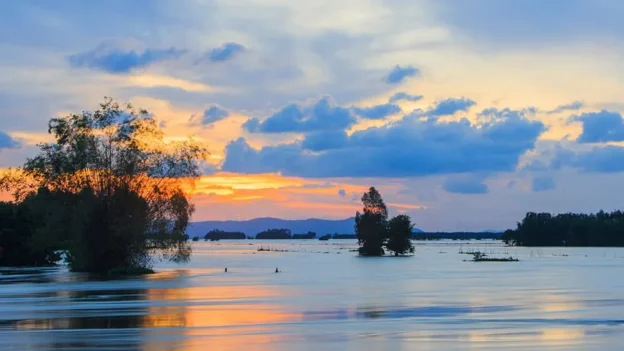For decades, Cambodia’s Tonlé Sap Lake has been an ecological and human mainstay in Southeast Asia, yet a new study published in Nature Sustainability and led by researchers at Loughborough University warns that increasing sand mining in the Mekong River is compromising the flow that feeds the lake and threatens to trigger a large-scale environmental crisis.
The lake’s water balance, in decline
Tonlé Sap Lake is the largest freshwater lake in Southeast Asia, a UNESCO Biosphere Reserve and an extremely productive and biodiverse ecosystem, which depends on a unique phenomenon called reverse flow. This phenomenon occurs in the monsoon season and occurs because the Mekong River carries so much water that it pushes and causes the Tonlé Sap River to flow backwards, filling the lake and expanding enormously.
This seasonal reversal creates an ideal habitat for fish breeding and nurtures biodiversity, as well as supporting the region’s fisheries and agriculture. However, the study revealed that between 1998 and 2018 the volume of this reverse flow has declined by 40-50% as a result of the lowering of the Mekong riverbed, which is directly linked to the intensification of sand mining and the accumulation of sediments retained by dams.
The role of sand mining
Sand mining has grown rapidly in the region, as it is essential for the construction industry. construction industry, and it is estimated that more than 100 million tons and it is now estimated that more than 100 million tons are extracted annually from the Mekong riverbed. This riverine plundering has altered the morphology of the river, reducing its ability to exert pressure on the lake during the monsoon and thus weakening the reverse flow.
Projections of the study indicate that by 2038, if the trend continues, the flow could fall by as much as 69% compared to 1998, which would put the system at risk of collapse.
What are the direct consequences?
This reduced flow into the lake has two serious and paradoxical effects on the Mekong Delta, home to 23 million people:
- Increased risk of flooding in the wet season: Since not as much water can enter the lake, this extra volume (about 26 km³) remains in the main channel of the Mekong, increasing the flow and the risk of overflows and flooding downstream.
- Increased risk of drought and saline intrusion in the dry season: The lake returns 59% less water to the delta during the dry season. This means:
- Less water for agriculture.
- It allows seawater to penetrate further inland into the delta (saline intrusion), ruining crops and freshwater aquifers.
Ongoing research and solutions
To further explore the consequences of this practice, the universities of Loughborough and Newcastle are creating new projects focused on analyzing how sand mining affects river channels and increases the risk of flooding. These initiatives aim to provide knowledge for more sustainable sediment management in the region.
The Tonlé Sap Lake is of vital importance to Cambodia’s ecosystems and communities. In recent years, local communities have noticed that the lake does not fill as much as it used to and that ecosystems that depend on prolonged flood seasons are coming under increasing pressure. If the Tonlé Sap Lake ecosystem is to be preserved, it is necessary to focus on maintaining or increasing the level of the Mekong River bed.
Dr. Chris Hackney, Senior Lecturer in Physical Geography at Newcastle University.
Source: Loughborough University

